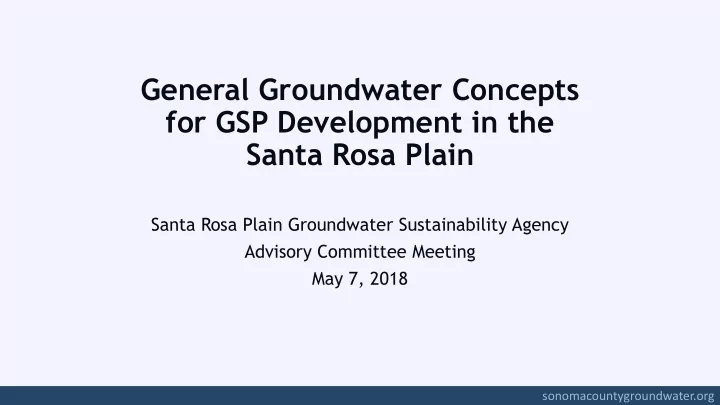

General Groundwater Concepts for GSP Development in the Santa Rosa Plain Santa Rosa Plain Groundwater Sustainability Agency Advisory Committee Meeting May 7, 2018 sonomacountygroundwater.org
Presentation Overview 1. Aquifer Properties and Groundwater Movement 2. Groundwater Levels and Surface Water-Groundwater Interaction 3. Groundwater Quality 4. Groundwater Budgets and Models 5. Questions & Discussion sonomacountygroundwater.org
Hydrologic Cycle US Geological Survey Circular 1139 sonomacountygroundwater.org
Aquifer Materials: Examples of Porosity • Specific Yield = Amount of water that drains from an unconfined aquifer • 20% Specific Yield example: • 1 cubic foot of aquifer material yields 0.2 cubic feet of water • 2 inches of recharge can raise groundwater levels nearly one foot sonomacountygroundwater.org
Aquifer Materials: Hydraulic Conductivity Darcy’s Law of Groundwater Flow (Q) • Hydraulic conductivity (K) • Hydraulic gradient (i) • Cross-sectional area of flow (A) Q = KiA Common methods for estimating Hydraulic Conductivity: • Aquifer Testing (pumping a well and measuring responses in nearby wells) • Aquifer material type (eg, infer from driller’s or geologist’s descriptions from well logs) • Numeric Modeling • Geophysical Surveys sonomacountygroundwater.org
Most Data on Aquifer Properties from Well Logs sonomacountygroundwater.org
Santa Rosa Plain Geology and Primary Hydrogeologic Units Alluvium/Glen Ellen Petaluma Wilson Grove Sonoma Volcanics Santa Rosa Plain sonomacountygroundwater.org Groundwater Subbasin
Santa Rosa Plain 3-D Lithology Model sonomacountygroundwater.org
Groundwater Movement Between Recharge and Discharge U.S. Geological Survey Circular 1139 sonomacountygroundwater.org
Unconfined and Confined Aquifers Heath, USGS Water Supply Paper 2220 Harter, UC Division of Ag and Natural Resources, Publication 8083 sonomacountygroundwater.org
Groundwater Levels Change Seasonally and Climatically Well Hydrograph, Groundwater and the Rural Homeowner, U.S. Geological Survey sonomacountygroundwater.org
Groundwater Levels Change When Discharge Exceeds Recharge Groundwater Elevation 20 10 0 -10 -20 -30 -40 1948 1958 1968 1978 1988 1998 Well Hydrograph, Water Well Database, California Department of Water Resources sonomacountygroundwater.org
Southern Santa Rosa Plain Example Hydrographs sonomacountygroundwater.org
Groundwater Levels in the Santa Rosa Plain: Changing Groundwater Flow Patterns 1951 • Less groundwater pumping • Groundwater flowing mainly east to west and discharging to Laguna de Santa Rosa 1990 • Increases in groundwater pumping through 1980s and 1990s • Pumping depressions developed in southern and western areas 2007 – 2015 • Reduction in groundwater pumping within southern area due to increased Russian River water use, conservation and recycled water use • Southern area pumping depression has predominantly recovered sonomacountygroundwater.org
Groundwater – Surface Water Connection Groundwater Affec “ ts Stream F ” low “Gaining Stream” High Groundwater Levels Groundwater Maintains Stream Flow Courtesy The Nature Conservancy sonomacountygroundwater.org
Groundwater – Surface Water Connection Groundwater Affects Stream Flow “Losing Stream” “Losing Stream” Pumping Lowers Groundwater Levels umping Lowers Groundwater Levels Stream Loses Flow to Groundwat Stream Loses Flow to Groundwater Courtesy The Nature Conservancy sonomacountygroundwater.org
Groundwater – Surface Water Connection Groundwater Affects Stream Flow “Losing Stream” “Losing Stream” Groundwater Levels Below Stream Channel Groundwater Levels Below Stream Channel Pumping Lowers Groundwater Levels Pumping Lowers Groundwater Levels Stream Loses Flow to Groundwater Stream Loses Flow to Groundwater Courtesy The Nature Conservancy sonomacountygroundwater.org
Groundwater – Surface Water Connection Groundwater Affects Stream Flow Dry Stream “Dry Stream” Seepage to Groundwater Exceeds Stream Flow Seepage to Groundwater Exceeds Stream Flow Dry Stream Channel (Intermittently or Year-round) Dry Stream Channel (Intermittently or Year-round) Pumping Lowers Groundwater Levels Pumping Lowers Groundwater Levels Stream Loses Flow to Groundwater Stream Loses Flow to Groundwater Courtesy The Nature Conservancy sonomacountygroundwater.org
Groundwater Quality Contaminant Hydrogeology, C.W. Fetter, 1992 sonomacountygroundwater.org
USGS Santa Rosa Plain Groundwater Study Groundwater Quality Sampling Over 160 Wells Sampled • Many wells in the Santa Rosa Plain produce high quality water • Large variability: some areas of naturally occurring iron, manganese, arsenic • Localized impacts of nitrates and organic contaminants • Higher salinity water with depth • Some secondary water quality parameters, including chloride and mineral content increasing in southern Santa Rosa Plain sonomacountyg roundwater.org Santa Rosa Plain Groundwater Subbasin
Conceptual Model Precipitation and streambed infiltration primary source of recharge Primary discharge: Pumping Evapotranspiration Baseflow Dominantly flows east to west Imbalance in the amount of inflows and outflows to the basin - could be exacerbated by future climate change. Historical areas of groundwater-level decline largely recovered due to replacing some groundwater use with surface water and recycled water supplies and conservation. sonomacountygroundwater.org
Groundwater Budget Inflows Outflows s Natural Land Streambed Well Streambed Groundwater Surface Pumping Discharge E vapotranspiration Surface Percolation Discharge Percolation Inflow Outflow From To Other Adjacent Aquifers Aquifers sonomacountygroundwater.org
Aquifer System and Groundwater Budget Responses to Groundwater Pumping Undeveloped Aquifer System: Natural Recharge = Natural Discharge to surface water, ET, and springs Developed Aquifer System: Sources of water to pumping wells = Some combination of: 1. increased recharge (conversion of gaining to losing streams) 2. reduction/capture of natural discharge to surface water/ET, and 3. removal of stored groundwater Natural Recharge ≠ Basin Sustainable Yield sonomacountygroundwater.org
Santa Rosa Plain GSFLOW Surface Water-Groundwater Model EXAMPLE MODEL INPUTS • Precipitation • Temperature • Stream segments & conductivity • Imperviousness • Soil moisture • Geology • Hydraulic conductivity • Groundwater wells EXAMPLE MODEL USES • Estimate hydrologic budget • Identify recharge areas • Evaluate water-resource management strategies • Evaluate climate-change impacts • Evaluate effects of changes in land-use sonomacountygroundwater.org
Simulated Groundwater Budget 1976-2010 Santa Rosa Plain Watershed Inflows = 80,600 Outflows = 83,900 Surface Streambed Well Streambed Groundwater Surface Pumping Discharge E vapotranspiration Percolation Percolation Leakage 35,600 25,800 41,000 32,400 8,500 6,100 Subsurface Subsurface Aquifer Aquifer Outflows Inflows 7,900 7,200 Values in Acre Feet Per Year son omacountygroundwater.org
SGMA Undesirable Results (1) Chronic lowering of groundwater levels indicating a significant and unreasonable depletion of supply if continued over the planning and implementation horizon. (2) Significant and unreasonable reduction of groundwater storage. (3) Significant and unreasonable seawater intrusion. (4) Significant and unreasonable degraded water quality, including the migration of contaminant plumes that impair water supplies. (5) Significant and unreasonable land subsidence that substantially interferes with surface land uses. (6) Depletions of interconnected surface water that have significant and unreasonable adverse impacts on beneficial uses of the surface water. sonomacountygroundwater.org
Questions and Discussion http://www.sonomacountygroundwater.org sonomacountygroundwater.org
Recommend
More recommend